Montserrat College of Art is a private, non-profit art college located in Beverly within Essex County of Massachusetts. The school is accredited by both the New England Commission of Higher Education and the National Association of Schools of Art and Design.

Richard Howard Hunt was an American sculptor. In the second half of the 20th century, he became "the foremost African-American abstract sculptor and artist of public sculpture." Hunt, the descendant of enslaved people brought from West Africa through the Port of Savannah, studied at the School of the Art Institute of Chicago in the 1950s. While there he received multiple prizes for his work. In 1971, he was the first African-American sculptor to have a retrospective at Museum of Modern Art. Hunt has created over 160 public sculpture commissions, more than any other sculptor in prominent locations in 24 states across the United States.

Butter sculptures are three-dimensional works of art created with butter, a dairy product made from the fat and protein components of churned cream. The works often depict animals, people, buildings and other objects. They are best known as attractions at state fairs in the United States as lifesize cows and people, but can also be found on banquet tables and even small decorative butter pats. Butter carving was an ancient craft in Tibet, Babylon, Roman Britain and elsewhere. The earliest documented butter sculptures date from Europe in 1536, where they were used on banquet tables. The earliest pieces in the modern sense as public art date from ca. 1870s America, created by Caroline Shawk Brooks, a farm woman from Helena, Arkansas. The heyday of butter sculpturing was about 1890–1930, but butter sculptures are still a popular attraction at agricultural fairs, banquet tables and as decorative butter patties.

Henry Spencer Moore was an English artist. He is best known for his semi-abstract monumental bronze sculptures which are located around the world as public works of art. Moore also produced many drawings, including a series depicting Londoners sheltering from the Blitz during the Second World War, along with other graphic works on paper.

Atlantic Center for the Arts (ACA) is a nonprofit, interdisciplinary artists’ community and arts education facility providing artists an opportunity to work and collaborate with contemporary artists in the fields of composing, visual, literary, and performing arts. Community interaction is coordinated through on-site and outreach presentations, workshops and exhibitions. The ACA is located in New Smyrna Beach, Florida. The complex was designed by the Boston-based firm Thompson and Rose Architects.
Thaddeus G. Mosley is an American sculptor who works mostly in wood and is based in Pittsburgh, Pennsylvania.
Hanna Jubran is a Palestinian Arab Israeli sculptor, born in Jish, the upper Galilee. His work addresses the concepts of time, movement, balance and space. Each sculpture occupies and creates its own reality influenced by its immediate surroundings. The work does not rely on one media to evoke the intended response, but takes advantage of compatible materials such as, wood, granite, steel, iron and bronze.

The Heide Museum of Modern Art, also known as Heide, is an art museum in Bulleen, a suburb of Melbourne, Victoria, Australia. Established in 1981, the museum houses modern and contemporary art across three distinct exhibition buildings and is set within sixteen acres of heritage-listed gardens and a sculpture park.
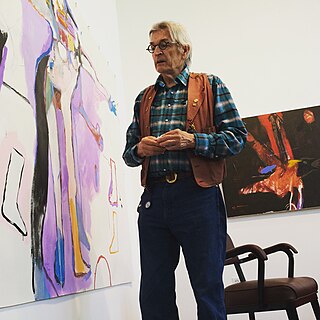
Richard Elmer "Rick" Bartow was a Native American artist and a member of the Mad River band of the Wiyot Tribe, who are indigenous to Humboldt County, California. He primarily created pastel, graphite, and mixed media drawings, wood sculpture, acrylic paintings, drypoint etchings, monotypes, and a small number of ceramic works.
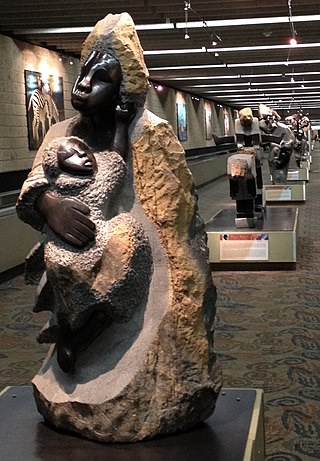
Sculpture and in particular stone sculpture is an art for which Zimbabwe is well known around the world.

Sean Kekamakupaʻa Lee Loy Browne was born in 1953 and raised on Hawaiian Homestead Lands in Keaukaha, Hilo, Hawaii. A graduate of the Kamehameha Schools class of 1971, he earned his Bachelor’s degree at the University of Redlands in 1975 and his Master of Fine Arts in sculpture from the University of Hawaiʻi at Mānoa in 1983. In 1981 he traveled to Pietrasanta, Italy to study marble carving under Paoli Silverio and was later accepted as an artist-in-residence at Henreaux Marble Company in Querceta, Italy. In 1985 he was awarded a Fulbright Fellowship, enabling him to study stone sculpture under the guidance of Isamu Noguchi in Shikoku, Japan. For many years, Browne taught sculpture at the University of Hawaiʻi at Mānoa and at Kapiʻolani Community College.
The Houston Alternative Art chronology was originally compiled by Caroline Huber and The Art Guys for the exhibition catalogue No Zoning: Artists Engage Houston, which was published by the Contemporary Arts Museum Houston (CAMH) to accompany the group show of the same name. The exhibition was on view at CAMH from May 9-October 4, 2009. No Zoning: Artists Engage Houston was co-curated by Toby Kamps and Meredith Goldsmith and featured projects by twenty-one Houston artists using the city as inspiration, material, and site. This chronology documents Houston's alternative art scene.

Kahlil G. Gibran, sometimes known as "Kahlil George Gibran", was a Lebanese American painter and sculptor from Boston, Massachusetts. A student of the painter Karl Zerbe at the School of the Museum of Fine Arts, Boston, Gibran first received acclaim as a magic realist painter in the late 1940s when he exhibited with other emerging artists later known as the "Boston Expressionists". Called a "master of materials", as both artist and restorer, Gibran turned to sculpture in the mid-fifties. In 1972, in an effort to separate his identity from his famous relative and namesake, the author of The Prophet, Gibran Kahlil Gibran, who was cousin both to his father Nicholas Gibran and his mother Rose Gibran, the sculptor co-authored with his wife Jean a biography of the poet entitled Kahlil Gibran His Life And World. Gibran is known for multiple skills, including painting; wood, wax, and stone carving; welding; and instrument making.
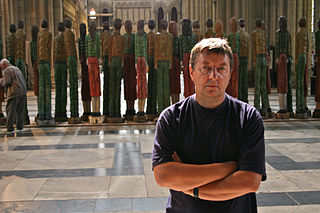
Robert Koenig is an English sculptor, who specialises in wood sculpture and is a prominent exponent of the art of woodcarving using the traditional tools of mallet and chisel. He is known for his carved and polychromed figurative wood sculptures, which he has been creating since the early 1980s. One of the earliest polychromed figures was shown in the 'Temple' exhibition at the Shaw Theatre, London in 1988.
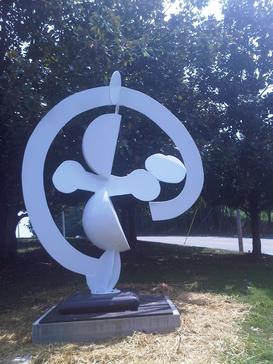
The Robert T. Webb Sculpture Garden is a five-acre (2.0 ha) admission-free, open-air museum and sculpture park located in Dalton, Georgia, near Chattanooga, Tennessee, and is operated by the Creative Arts Guild, the state's oldest multi-disciplinary, community arts organization. The sculpture garden is the first permanent installation of its kind in the state of Georgia The garden features more than 50 outdoor sculptures in three sections of the Guild's property—the Ken and Myra White Magnolia Crescent, the Eli Rosen Garden and the Founders Garden—that provide an organic setting for the works, including mature trees, shrubs and flowers. The garden includes works by prominent artists such as Isamu Noguchi, Scott Burton, James Rosati, Betty Gold, Victor Salmones, Guy Dill, Chana Orloff, Felipe Castaneda and Ken Macklin. The Creative Arts Guild also maintains an indoor art gallery, which hosts rotating exhibits by local, regional and national artists. The sculpture garden welcomes approximately 10,000 visitors each year and is an educational resource for regional schools.

Robert Henry Hess was an American sculptor and art educator. He was best known for his abstract metal sculptures and wood carvings. Hess served on the faculty of Willamette University in Salem, Oregon, for 34 years. Today, his works are found in prominent public spaces and private collections throughout the Pacific Northwest.
Clive Robertson, is a Canadian performance and media artist, critic, curator, publisher and retired Queen's University art history professor. He is based in Kingston, Ontario.
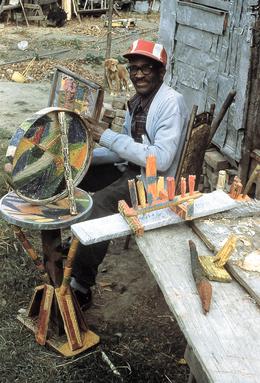
Leroy Person (1907–1985) was an American sculptor and wood carver from a remote region in northeastern North Carolina. Person's sculptures, and later, drawings, are recognized for their particular sensitivity to color and surface markings.











